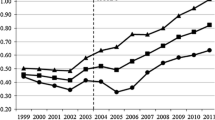Abstract
The purpose of this paper is to analyse the relationship between bureaucracy and research performance within Public Research Bodies. The research methodology is applied on a sample of 100 interviewed belonging to 11 institutes of National Research Council of Italy. The main finding is that within Italian Public Research Council there is academic bureaucratization that reduces performance and efficiency of institutes. In fact, institutes have two organizational behaviours: high bureaucracy — low performance and low bureaucracy - high performance. These bureaucratic tendencies are also present in other countries and particularly: the public research labs have an academic bureaucratization because of administrative burden necessary to the governance of the structures, whereas the universities have mainly an administrative bureaucratization generated by the increase of administrative staff in comparison with researchers and faculty.
Similar content being viewed by others
References
Aghion, P., Howitt, P. (1998), Endogenous Growth Theory. The MIT Press, Cambridge.
Arrow, K. (1962), Economic welfare and the allocation of resources for invention, In: R. R. Nelson (Ed.), The rate and direction of inventive activity: economic and social factors, Princeton University Press, Princeton.
Banarjee, A. V. (1997), A theory of misgovernance, Quarterly Journal of Economics, 112(4): 1289–1332.
Bozeman, B., Rainey, H. G. (1998), Organizational rules and the bureaucratic personality. American Journal of Political Science, 42(1): 163–189.
Bozeman, B., Stuart, B. (1994), The publicness puzzle’ in organization theory: A test of alternative explanations of differences between public and private organizations. Journal of Public Administration Research and Theory, 12(4): 197–223.
Bozeman, B., Reed, P., Scott, P. (1992), The presence and predictability of red tape in public and private organizations. Administration and Society, 34(24): 290–322.
BRTF (2005), Less is more: reducing burdens, improving outcome, Better Regulation Task Force, London.
CNR Report (2003), Risultati di Ricerca. D’Anselmi Editore/Hoepli, Roma.
Coccia, M. (2007), Does Bureaucracy affect performance of public research organizations? In: Proceeding of ISSI 2007, D. Torres-Salinas, H. F. Moed (Eds), CINDOC-CSIC, Graesal, Madrid, Spain.
Coccia, M., Rolfo, S. (2007), How research policy changes can affect organization and productivity of public research institutes? Analysis within the Italian national system of innovation, Journal of Comparative and Policy Analysis, 9(3) 215–233.
Coccia, M., Gobbino, A. (2006), Analisi della burocrazia negli enti pubblici di ricerca. Working paper Ceris-Cnr, n. 5, Moncalieri (To).
Coccia, M. (2004), Models for measuring the research performance and identifying the productivity of public research institutes. R&D Management, 34(3): 267–280.
Coccia, M. (2005), Scientometric model for the assessment of the scientific research performance within the public institutes. Scientometrics, 65(30): 297–311.
Crow, M., Bozeman, B. (1989), Bureaucratization in the laboratory. Research Technology and Management, 32(5): 30–32.
Crow, M., Bozeman, B. (1998), Limited by Design. R&D Laboratories in the U.S. National Innovation System. Columbia University Press, New York.
Crozier, M. (1964), Bureaucratic Phenomenon. University of Chicago Press, Chicago.
Gore, A. (1993), From Red Tape to Results: Crating A Government That Works Better and Costs Less. Government Printing Office, Washington.
Gore, A. (1995), Common Sense Government. Random House, New York.
Gornitzka, A., Svein, K., Larsen, I. M. (1998), The Bureaucratization of universities. Minerva, XXXVI(1): 25–47.
Gumport, P., Pusser, B. (1995), A case of bureaucratic accretion. Journal of Higher Education, 66(5): 493–520.
Heckman, J., Heinrich, C., Smith, J. (1997), Assessing the performance of performance standards in public bureaucracies. American Economic Review. Paper and Proceeding, 87(2): 389–395.
Herbst, M. (2004), Governance and management of research universities: funding and budgeting as instruments of change. Center for Science and Technology Studies, vol. 4, Bern, CH. ISTAT (1991–2004), Annuari Statistici. Roma.
Keyworth, T. (2006), Measuring and managing the costs of red tape: a review of recent policy development, Oxford Review of Economic Policy, 22(2): 260–273.
Kogan, M. (1996), Academics and Administrators in Higher Education, paper for the CHER Conference, Turku, June.
Lane, J. E. (1990), Institutional Reform a Public Policy Perspective. Dartmouth Publishing Co, Aldershot.
Laredo, P. M., Mustar, P. (2004), Public sector research: A growing role in innovation systems, Minerva, 42(1): 11–27.
Lundvall, B. (1992), National Systems of Innovation, Pinter Publishers, London.
Meier, K. J., Polinard, J. L., Wrinkle, R. D. (2000), Bureaucracy and organizational performance: causality arguments about public schools. American Journal of Political Science, 44(3): 590–602.
Merton, R. K. (1970), Teoria e Struttura Sociale. Il Mulino, Bologna.
OECD (2003), From Red Tape to Smart Tape: Administrative Simplification in OECD Countries, OECD Publishing, Paris.
Porter, M. E. (1990), The Competitive Advantage of Nations, Billing & Sons, Ltd, Worcester.
Weber, M. (1921), Economy and Society. Bedminster Press, Totowa, New Jersey.
Weber, M. (1964), The Theory of Social and Economic Organization. Collier Macmillan, New York.
Author information
Authors and Affiliations
Corresponding author
Rights and permissions
About this article
Cite this article
Coccia, M. Research performance and bureaucracy within public research labs. Scientometrics 79, 93–107 (2009). https://doi.org/10.1007/s11192-009-0406-2
Received:
Published:
Issue Date:
DOI: https://doi.org/10.1007/s11192-009-0406-2




